Author: Juliet Tang, Investment Analyst at Huobi Ventures
Every bull market has a different engine, and behind every bull market engine is a long and winding bear market development process. Crazy MEMEs, the summer of DeFi… With the development of Web3 technology and infrastructure, the social track has also ushered in new opportunities for development.
Will the Web3 social track be the next bull market engine? As a track that requires developers’ imagination to fully play out at the application layer, social, identity, NFT, DAO fans, etc. can all be classified into the category of Web3 social. The social track is still in its very early stages, and with the launch of the Cyber token, Twitter’s rebranding, and creator incentive programs, the market heat of the social track is gradually increasing. Friend.Tech, a social application on the L2 chain BASE, quickly gained popularity since its launch on August 10th, with over 120,000 registered addresses and over 20,000 active addresses in less than 20 days. Applications such as CyberConnect and Lens Protocol have also attracted a large number of users and market attention. This article explores the current development status and product characteristics of Web3 social, and also analyzes several leading projects in the track. In addition, the risks and challenges faced by this track are also studied. Overall, the future of the Web3 social track looks promising, and this sector has good investment potential and development prospects. This research report is produced by Huobi Ventures, the global investment division of Huobi, which integrates investment, incubation, and research to identify the world’s best and most promising projects.
Why pay attention to social?
The crypto track has always been seen as an interdisciplinary science that combines computer science, finance, cryptography, mathematics, and other disciplines. However, due to its short history, incomplete infrastructure, inconsistent regulatory standards, and certain learning thresholds and costs, it has not yet achieved widespread popularity and use on a global scale. With the increasingly perfect construction of smart contract public chains represented by Ethereum, the development of on-chain Dapps has also exploded since 2020, as shown in the figure below. The cumulative number of Defi user addresses has exceeded 40 million. Defi has led users to interact on the chain, and its real and convenient application scenarios have driven the construction and development of the on-chain economy, attracting and cultivating a group of on-chain Degen. Since 2021, blockchain games and NFTs have led a new wave of users. The new on-chain gameplay, the token economic design of Ponzi effects, and the diverse value system have helped the Web3 field attract a large number of new users. In terms of blockchain games, due to their gold farming effects, they have attracted a large number of Web2 gamers and low-income individuals from the third world. On the other hand, NFTs have also attracted a large number of collectors, art enthusiasts, and traditional brand merchants due to their identity value, collectible value, and brand value.
Total number of Defi user addresses across the entire chain

Source: https://dune.com/rchen8/defi-users-over-time
Since 2022, the market has entered a long bear market. The initial hype around games, NFTs, and other sectors has cooled down. Ponzi schemes have collapsed rapidly due to insufficient growth, and the growth of Web3 users has reached a bottleneck. Currently, Web3 innovation is still ongoing, with developers continuously exploring new possibilities in areas such as infrastructure, zero-knowledge proofs, payments, identity, and Defi 2.0. However, the lack of users is still one of the core problems faced by the development of the Web3 field. In the current bear market, a large number of ecosystems and projects face the dilemma of completed construction but lack of real users. Excluding various airdrop studios and multi-wallet users, the number of real on-chain users may not be optimistic.
From the supply side, the current development of Web3 requires the expansion of more application scenarios and the creation of more ways to attract new users. Currently, the social sector is expected to become the next explosive sector for Web3 users. From the demand side, the social sector has already proven its strong potential in the traditional internet field, with a huge user base and commercial value fully realized. From the early days of MSN to the middle period of Facebook, Instagram, and later TikTok, each technological iteration in the social sector has accompanied the birth of internet giants and triggered a large number of upstream and downstream job opportunities in the industry chain. As people’s awareness of the privacy value and commercial value of data ownership increases, more and more voices are calling for users to control their own social information and data through Web3 and to enjoy the value of their own identity and behavioral data. Therefore, the exploration of social projects in the Web3 field is one of the most promising and commercially valuable topics in the near future.
With the maturity of ecosystems such as Cyber Connect and Lens Protocol, the entire social sector ecosystem is becoming more and more robust. The current social sector is in the early stage of explosive growth, and some social projects have already attracted market attention. For example, the largest KOL in the cryptocurrency world, Elon Musk, took over Twitter, and his actions, such as repeatedly promoting Dogecoin and including Bitcoin in Tesla’s official documents, have brought global attention to the cryptocurrency field. Although he stated that Twitter will never issue tokens, speculation about social identities, token rewards, and payments has been widely discussed in the market. In addition, Lens Protocol raised $15 million in funding, Instagram and other internet social giants issued NFTs, and Cyber tokens were simultaneously listed on multiple leading exchanges, indicating industry expansion and development.
Characteristics of the social sector
For Web3 social platforms, there is currently no unified definition. We can categorize all products that involve the publishing, exchange, and user portrayal of information between people into the field of social platforms. Based on the current development achievements, this mainly includes social public chains, social graphs, social identities, various types of social applications, and service tools.
In the field of Web2, traditional social platforms such as Twitter, Instagram, and Tiktok already have a large number of users and have developed mature and rich business models. When it comes to Web3 social, it is necessary to verify the necessity and feasibility of Web3 social development. Compared with Web2, Web3 has a smaller user base in social development and is currently in the stage of technical exploration. In general, this article believes that the key factors for the development of Web3 social include:
1. Anonymity and Censorship Resistance
Compared to Web2 social, one of the biggest advantages of Web3 social is anonymity and censorship resistance, which has already been proven to be a demand among users. In the Web2 field, data is controlled by centralized institutions, and users may be subject to arbitrary censorship of their data information, forced to delete or modify their social comments, etc. Essentially, Web2 social is still a social model under a regulatory system, and users cannot protect their privacy. On the other hand, decentralized Web3 naturally has the characteristics of protecting user privacy and resisting centralized institutional censorship, which can meet the demands of users to protect their privacy and maintain their own security.
2. User Ownership of Data
In the Web2 social model, the ownership of user data belongs to centralized platform institutions. By controlling user data, platforms can create user profiles, analyze user behavior preferences, and deliver relevant advertisements and products to maximize traffic monetization. At the same time, the data itself also has certain commercial analysis value. In the Web3 field, allowing users to own data can enable them to obtain the commercial value of data traffic. From the user’s perspective, projects that allow users to easily monetize their data value are attractive. In fact, this model has been attempted in the business models of Web2 and has achieved certain results. For example, Pinduoduo provides cash rewards for watching videos and inviting friends to participate in “group buying” (essentially new user acquisition) to earn cash rewards, which are attempts to monetize traffic for users. Currently, there have been many attempts in the Web3 field in this area, such as Nostra based on the Bitcoin Lightning Network, Lens based on Polygon, and multi-chain protocol CyberConnect, all of which are attempting to return data ownership to users. This article believes that in Web3, due to the diversity of tokens, the volatility of token value, and the richness of token economic design, there can be many interesting ways to derive the commercial value of data ownership, which may even surpass the wealth creation and new user acquisition effects created by the previous bull market of blockchain games.
3. Simplicity and Ease of Use
One of the elements of social projects is to achieve abundant and free flow of information within the community, which relies on a large number of users. How to attract a large number of users is the biggest challenge and opportunity for Web3 social projects. One of the important reasons for the limited development of the crypto field is the small user base. Firstly, there is a certain learning curve for users to enter the crypto field. Users need to master certain computer and encryption knowledge to participate in on-chain interactions. Secondly, compared to Web2 user tools, current crypto projects are more complex and not as simple and convenient. For example, the EOA wallet has complex mnemonic phrases and storage methods, potential risks of phishing and private key theft, and issues with software updates, iterations, and compatibility, all of which affect user experience. Keeping a large number of Web2 users outside the crypto world also means that once the issues of learning costs and entry barriers are resolved, the birth of a social project that is easy to use and allows users to operate seamlessly will bring huge user traffic.
4. Interoperability
In Web2 social networks, due to the existence of various centralized institutions, a large number of data silos have actually been formed. Internet giants formed by these huge data silos have data access permissions and pricing power. Other projects in different categories need to obtain permission from all data institutions in order to use the data or build applications on it. At the same time, there are compatibility issues and potential competition among these huge data silos. As a result, many Web2 applications are not interoperable, and users often have to register a new account and accumulate information and data when using a new platform. This article believes that ideal Web3 social products may have the opportunity to solve the problem of data silos. The depiction of user profiles in projects such as POAP and ENS can be seen as attempts to solve the problem of data silos. In the future, there may be simpler and more accessible standard protocols that help users easily control data ownership while being compatible with most protocols. This is one of the key exploration directions of DID in this field.
Overview of Head Projects
According to different project types, social projects mainly include social graphs, social applications, and tool projects.
Social Graphs
Social graphs serve as infrastructure in Web3 social networks, providing general standards and data information sources for other application projects. Social graphs should have rich data sources, extensive interoperability, and low barriers to use. From this perspective, the necessity of building standalone social projects on new public chains or native social projects on obscure public chains is not significant, as it increases isolation from other mature ecosystems. Currently, social identity general standards built on mature chains are the mainstream choice for the development of social graphs. Projects in this track include Lens Protocol, CyberConnect, and RSS3.
CyberConnect
CyberConnect is a multi-chain social graph that can verify and store user interaction data, providing users with personal profiles, social graphs, and smart contract wallets. It also provides standard API data interfaces for other DApp developers to enable user data migration across multiple DApps. Currently, CyberConnect has integrated with networks such as Polygon, Linea, and Optimism, and will further integrate with Arbitrum, expecting further user growth. As shown in the following figure, as of August 8, 2023, there were a total of 368k accounts and 738k user operations, with a total of over 1.25m user profiles.
CyberConnect User Data

Source: https://dune.com/cyberconnecthq/cyberaccount-cyberconnects-4337-smart-account
Despite the current sluggish market conditions, CyberConnect’s daily average traffic DAU still maintains above 10k, with overall high traffic.
CyberConnect Traffic Data
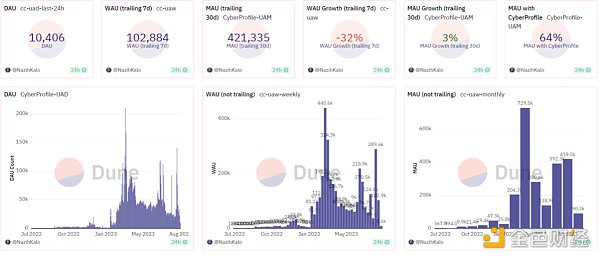
Source: https://dune.com/cyberconnecthq/cyberconnect-link3-metrics
Lens Protocol
Lens Protocol is a social project developed by the well-known DeFi lending project AAVE team. It is a social graph protocol built on Polygon that allows anyone to create unmanaged social profiles and build new social dApps. Users can create their own social profile NFTs by accessing wallets and interact with other users using these social profiles. Users can also build interactive dApps based on Lens (users can use Lens to log in, interact within the Lens ecosystem, and the interaction records will be recorded in the Lens social profile).
The following figure shows some projects in the Lens ecosystem. Currently, over 100 projects have been built on the Lens ecosystem, including various social, gaming, media sharing, DAO tools, ad management, information delivery, knowledge payment, and lottery dApps. Although most of the ecosystem projects are still in the early to middle development stages, the overall richness in terms of quantity and types is very high, even surpassing some public chains. In general, the blockchain-based social ecosystem created by Lens is very friendly to creator economy.
Lens Protocol Ecosystem Projects

Source: https://twitter.com/rekktguy/status/1582288617229406209?s=20
As of July 2023, over 110,000 addresses have obtained Profile social profiles. As shown in the figure below, Lens has accumulated more than 360,000 users and over 21.93 million transactions. The peak of transactions and user numbers occurred in February 2023, indicating the participation of a large number of retail investors or airdrop studios. Currently, the daily on-chain transaction volume is between 15,000 and 20,000 transactions, and the number of users participating in interactions daily ranges from 3,000 to 5,000 wallet addresses. Despite the bear market background, there are still a considerable number of users participating in social track interactions, demonstrating good user data performance and growth potential in this field.
Lens Protocol User Data

source: https://dune.com/sixdegree/lens-protocol-ecosystem-analysis
In general, the social graph is the infrastructure and general tool for the entire social track. A unified, simple, and convenient social graph helps reduce user barriers and usage barriers between different dApps, while also accumulating more users and data. In comparison, Lens Protocol is built on Polygon and focuses on creating its own social ecosystem, while CyberConnect does not have its own content platform and ecosystem. It supports multiple chains and interacts with multiple applications, and actively explores the entry of Web2 users through wallets, focusing on creating open social profiles. These two projects currently belong to the leading projects in the social track, and with the further development and launch of Lens Protocol, the social track led by these two projects may enter a period of explosive growth.
Social Applications
Farcaster
Farcaster is a decentralized social platform created by Dan Romero, former executive of Coinbase. It is built on Ethereum and is comparable to Twitter. Currently, it is in the beta testing phase. Farcaster generates and stores user identity information on the blockchain and provides a database hub to store other information off-chain, achieving a fast and low-cost decentralized social interaction experience comparable to Web2. In addition, Farcaster allows users to use self-custody mode, enabling users to send and receive messages without gateways, ensuring decentralized implementation. Currently, there are nearly 20 derivative projects built under its ecosystem, including data analysis, image beautification, hot topics, related topics, and search engines, etc.
As of August 9, 2023, the total number of Facaster wallet addresses has exceeded 13k, including several industry Degen in the crypto industry such as V God have registered accounts. The user growth rate for the week is 2.2%, with 2.5k dynamic posts published in the past seven days. As an independent social application, the number of users and user activity level is good.
Currently, in addition to the advantages of decentralized anonymity, how to attract Web2 users to migrate from Twitter to Farcaster is an important research direction for the project’s future development.
Facaster User Data Statistics

Source: https://farcaster.network/
Nostr
Nostr is a decentralized open-source social transmission protocol that developers can use to build Dapps. There are no centralized servers on Nostr, and the protocol achieves information transmission through the design of clients and relays. Compared to Web2 social media, this protocol achieves complete decentralization and can resist censorship and protect user privacy. Damus is a decentralized Twitter-like social product built on Nostr. Users can enjoy decentralized, anonymous, and ad-free features on a social platform similar to Twitter. The product is currently in the early stages of development and has also received recommendations and support from Jack Dorsey, the founder of Twitter.
As a completely open and anonymous decentralized anti-censorship product, Damus has strong competitiveness in terms of privacy and security compared to traditional social media products. It has a clear market and target customers. However, to attract a wider range of Web2 users, new product designs and features may be needed.
Friend.Tech
Friend.Tech is a social application deployed on the Coinbase series L2 chain BASE, which is invested by LianGuairadigm. This application is similar to traditional fan token/creator economy projects. The platform provides creators with fan communities and token issuance services. Users join the creator’s community by holding tokens issued by the creator. Since its launch on August 10th, the product has quickly gained popularity. As shown in the figure, as of August 29, 2023, in less than 20 days since its launch, there have been over 120,000 registered addresses, and the number of active addresses (users viewing user spaces on the day) exceeds 20,000.
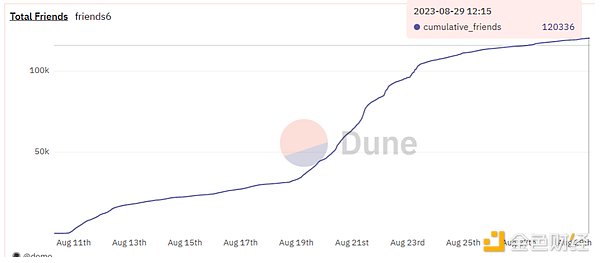
Source: https://dune.com/domo/friendtech
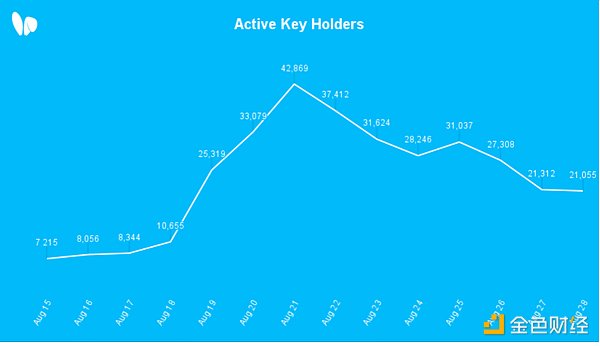
Source: https://twitter.com/friendtech/status/1696599323637846444/photo/1
Users need to pay a 10% transaction fee for each transaction, with 5% going to the creator and 5% going to the protocol. As shown in the figure below, as of August 28, 2023, the protocol has accumulated more than $4 million in revenue.
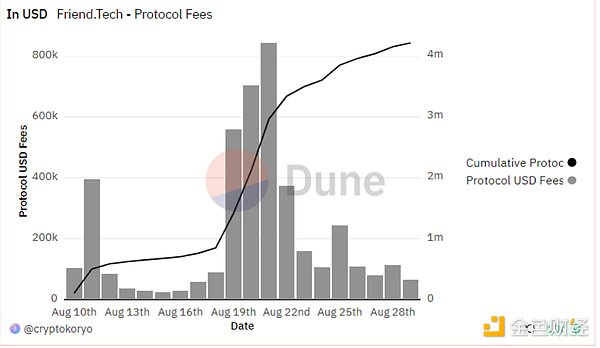
Source: https://dune.com/cryptokoryo/friendtech
The rapid popularity of the Friend.Tech product has to some extent attracted attention and speculation in the market about the social media track, and how the product has attracted users so rapidly and on such a large scale. This article believes that, in terms of the product itself, Friend.Tech has not yet deviated from the design of the original social product and token model. However, the success achieved in this stage can be traced, mainly including the following points:
1. Ponzi Economic Design for Fan Tokens
Currently, there are mainly two models for the design of fan tokens: one is the issuance of fan tokens, where users can gain entry into the creator community by holding a certain amount of fan tokens. The price of fan tokens follows the market economy and there may also be features such as buybacks, burning, profit sharing, and staking; the other is the issuance of fan NFTs, where users can gain entry into the creator community by holding NFTs. The price of NFTs also follows the market economy, and there may be features such as the mapping of new tokens, airdropping of new NFTs, or other rights implementation.
In general, in the token economic design prior to Friend.Tech, the buying and selling of fan tokens were mainly driven by users’ love for creators, and the attraction of token price fluctuations was neutral. However, Friend.Tech’s introduction of the user invitation mechanism + fan token economics has subverted the previously lackluster token economic mechanism. Friend.Tech has announced the distribution of 100 million points within six months, but the distribution rules have not been disclosed yet. However, it is widely believed that user points are linked to token airdrops. The combination of this mechanism and the user invitation mechanism promotes the motivation for user acquisition and also encourages users to purchase more shares of different creators to generate transaction fees and data. This strategy is similar to Blur’s airdrop strategy, which attracts users to use the product through long-term point incentives + airdrop expectations. Due to the long cycle, it can increase user stickiness and continue to occupy market share after the airdrop cycle ends.
In terms of token economics design, since the official calculation has not been disclosed, based on Laurence Day’s widely accepted calculation of the price model, as shown in the graph below, Friend.Tech’s fan token price follows the price curve of P=suppy^2/16000. Under this pricing model, both price increases and decreases will exhibit exponential fluctuations. Early investors have the opportunity to enjoy huge profits. This Ponzi economic design will continue to trigger price spikes before the buying and selling users reach equilibrium, attracting more speculative users to participate in token trading. This is also one of the most important reasons for the short-term explosion of projects. Similar designs can also be seen in the Meme project XEN, where the token design of Ponzi economics and the early user dividend incentive mechanism ignite market hotspots in a short period of time.
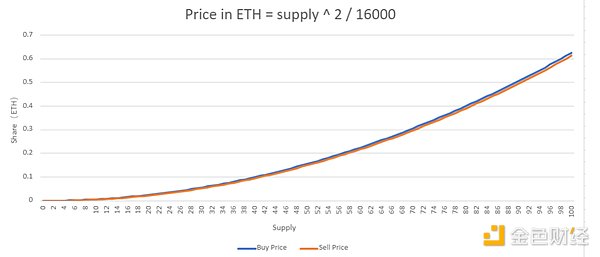
Source: https://onedrive.live.com/view.aspx?resid=C078415A103A3F40!1094&ithint=file%2cxlsx&authkey=!ANE0-sqb5hAftiI
2. Early Bonuses of BASE Chain Launch
Friend.Tech was initially built on other chains, and its recent launch and popularity in the BASE and L2 tracks are closely related. Since the launch of Arbitrum in early 2023, the L2 track has performed very well in the bear market. The subsequent ecosystems of Zksync, OP Stack, BASE, etc., have sparked market enthusiasm. It is expected that there will be the launch and token issuance expectations of Starknet, Scroll, and Zksync this year, coupled with the upcoming Cancun upgrade. The entire L2 can be considered the most important and eye-catching track in the crypto industry in 2023, and BASE is also backed by Coinbase, a listed exchange in the crypto industry. Friend.Tech chose to launch on BASE during its early stages, cleverly capturing the market’s hotspots and timing bonuses.
3. Endorsement from top VC background of Paradigm
As a top investment fund in the cryptocurrency industry, Paradigm’s endorsement naturally adds a lot of points to the project. Even though Friend.Tech has not developed a good web version yet, and only has a rough beta version with a lack of various project whitepapers and explanatory materials, the market still trusts the project and invests a lot of enthusiasm, which is closely related to Paradigm’s endorsement. At the same time, from the project’s scoring mechanism, we can see a similar incentive design to Blur, which may have the guidance of Paradigm.
Overall, Friend.Tech is relatively traditional in terms of product mechanism, but more daring in token economic design, customer acquisition strategy, and marketing tactics compared to traditional social projects. In the short term, Friend.Tech may replicate Blur’s user growth path, but as a social product, the realization of long-term social attributes needs to be observed after the product goes live.
Utility Projects
Social utility projects mainly serve as service functions, most of which are currently positioned to serve projects and DApps, such as Lenscan for browsing data under LensProtocol, LensDAO for organization and community management, Alertcaster for information reminders under Farcaster ecosystem, and FarQuest for conducting surveys. Other miscellaneous auxiliary tools can also be classified as social utility tools, such as Debank Hi module for social promotion, Utopia for DAO treasury governance, as well as various NFT design tools, account management tools, wallet management tools, etc.
Overall, the social track is a field that fully unleashes the imagination of developers at the application layer. In addition to social graphs and application tools, various types of social platforms, fan platforms, and streaming platforms are particularly diverse. Currently, this track is still in the very early stage, and the enthusiasm and efforts of developers and capital will continue to help accumulate achievements in this track.
Risks and Challenges
The current encrypted social track has attracted the participation of many developers and capital. While seeing opportunities, we should also be clear about the risks and challenges currently existing in this track. The current problems mainly lie in the aspects of technology, user growth, and compliance.
Technological Challenges
Social products as a whole are at the application layer and their development depends on the maturity of infrastructure and technology. With the growth of the user base, social products will face higher and more demanding requirements. At the same time, the development of social applications relies on solving problems such as data storage, cross-chain information transmission, information transmission costs, network congestion, etc. However, the current infrastructure is still not capable of accommodating the emergence of large-scale user social software at the level of Web 2.0.
User Growth
In addition to anonymity and censorship resistance, why would Web 2.0 users be willing to switch to Web 3 social applications? It can be clearly stated that not every user has extremely high privacy requirements. There are a large number of users who can still meet their social needs on existing centralized social platforms. Apart from these users, how to attract more users? Or should the target users focus only on users with privacy needs? If considering using economic incentives to motivate users, how to design an economic model that avoids falling into an economic closed loop or Ponzi economic dilemma? At the user level, Web 3 social has gained good market popularity and traffic, but currently, the popularity still remains within the cryptocurrency circle. Whether the future should focus on solving existing problems of social products or creating new features and demands is a question that Web 3 social products need to face in order to increase the number of users.
Compliance
The selling points that differentiate Web3 social products from Web2 products mainly include three aspects: decentralization, resistance to censorship, and privacy protection; users have ownership of their data; users can benefit from data ownership. The advantages of Web3 social products may also become their risks to some extent. It can be foreseen that the characteristics of Web3 products are highly attractive to practitioners in the black and gray industries, and they will also attract the attention of regulatory authorities. With the maturity of the Web3 track and the expansion of the user base, developer security issues and potential regulatory inquiries need to be considered in advance.
Summary
The Web3 social track is in the early stage of development, relying on the maturity of other infrastructure construction, including but not limited to cross-chain information transmission, data storage, reduction of transaction costs, and compliance issues. Currently, social track products mainly include social graphs, social tools, and social applications, among which social graphs are the most fundamental, and social applications have the largest number and widest range of categories. Currently, a large number of developers are trying to develop Web3 social products, and capital is gradually paying attention to and investing in this track. The launch of Cyber tokens, the renaming of Twitter, and creator incentive programs all demonstrate the increasing market enthusiasm for the social track. While social opportunities are emerging, it is also necessary to fully realize the challenges faced by the track, which, in this article, are believed to mainly include the current imperfection of infrastructure-type technical construction, potential bottlenecks in new user growth, and potential compliance issues. Overall, this article believes that Web3 social track performs well in terms of development prospects, development trends, and market enthusiasm. With the improvement of infrastructure, project development, capital aggregation, and token listing, this article believes that this sector has good investment potential and development prospects.
References
Web3 Social: Road to Mass Adoption (binance.com)
https://messari.io/report/web3-social-usage-and-engagement
Web3 Fundraising Report for Q2 2023: Trends in Gaming and Social Network
Similar Paths with Different Origins: The Decentralized Social Paths of Lens and CyberConnect – Biteye (mirror.xyz)
Who Can Become a Hit? A Review of Popular Web3 Social Track Projects – Web3Caff
https://medium.com/@Cobo_Global/socialfi-fdb821e1e7da
Like what you're reading? Subscribe to our top stories.
We will continue to update Gambling Chain; if you have any questions or suggestions, please contact us!